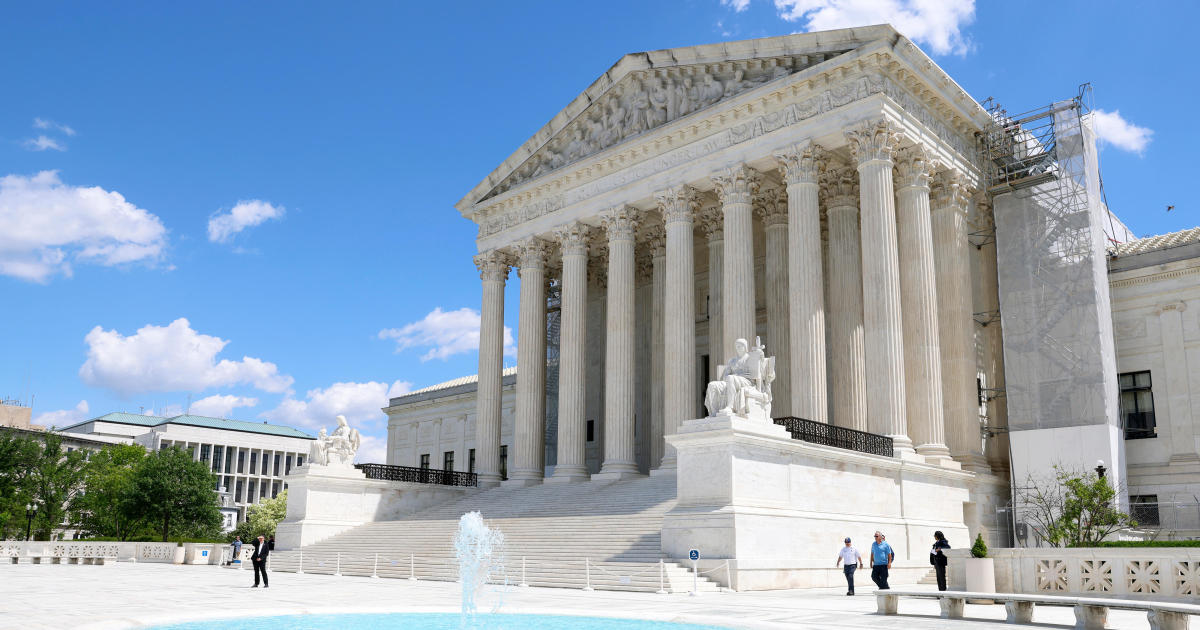Ohio voters approve amendment to establish right to abortion in state constitution, CBS News projects
Washington — Ohio voters have approved a ballot measure to amend the state constitution to establish a right to abortion, CBS News projects, delivering a crucial victory for abortion rights and adding momentum behind efforts to protect abortion access through citizen-led initiatives in the wake of the Supreme Court's reversal of Roe v. Wade.
The projected success of the ballot initiative in the red state of Ohio is likely to buoy Democrats' hopes that reproductive rights will continue to be a salient issue for voters nearly 17 months after the Supreme Court's decision rolling back the constitutional right to abortion. Voters' approval of the measure Tuesday, which is known as Issue 1, extends the winning streak for abortion rights proponents, who saw success in all six states where abortion-related measures were on the ballot last year.
With 99% of the vote in, the measure was passing by a margin of 56.6% to 43.4%.
The proposal to enshrine abortion access in the Ohio Constitution was the only one involving reproductive rights directly before voters this election and the first in which voters in a Republican-controlled state were asked to affirmatively guarantee the right to an abortion in the state's founding document.
In a statement released Tuesday night, President Biden celebrated the results and reiterated that his administration will work to protect access to reproductive health care. The president again called on Congress to codify the right to abortion in federal law.
"Ohioans and voters across the country rejected attempts by MAGA Republican elected officials to impose extreme abortion bans that put the health and lives of women in jeopardy, force women to travel hundreds of miles for care, and threaten to criminalize doctors and nurses for providing the health care that their patients need and that they are trained to provide," Mr. Biden said. "This extreme and dangerous agenda is out-of-step with the vast majority of Americans."
Abortion-rights advocates also cheered the ballot initiative's approval as a victory for reproductive freedom.
"This election, Ohioans chose hope. They chose a future for Ohio where people have control of their own bodies and lives, without government interference. And they did so even in the face of state officials — from the governor's office down — spouting lies, purging the voter rolls, and meddling in the fairness of this election," Alexis McGill Johnson, president of Planned Parenthood Action Fund, said in a statement.
After the Supreme Court overturned Roe, Ohio was one of several states where abortion rights advocates looked to citizen-driven ballot initiatives to protect abortion rights after stringent restrictions were allowed to take effect. Efforts are already underway in several more states, including Florida and Arizona, to put access to abortion directly before voters in the 2024 election.
The question before voters in Ohio was whether to amend the state constitution to create an individual right to reproductive freedom, which includes decisions on abortion. A majority "yes" vote was needed for the ballot measure to pass.
A CBS News poll conducted before Election Day found that 57% of Americans believe abortion should be legal in all or most cases, compared to 42% who think it should be illegal. Additionally, 74% of Americans are concerned that pregnant women may be more at risk in states with restrictions on abortion, 60% are worried about hospitals and maternity care centers closing, and 52% are concerned about doctors leaving those states.
What is Issue 1?
Issue 1 was a ballot measure to change the Ohio Constitution to include protections for abortion access. According to ballot language, the measure would establish in the state constitution "an individual right to one's own reproductive medical treatment," including to make decisions on abortion, contraception, fertility treatment, continuing one's own pregnancy and miscarriage care.
The amendment, titled "The Right to Reproductive Freedom with Protections for Health and Safety," protects any person or entity that helps a patient receive reproductive medical treatment and prohibit Ohio from "directly or indirectly burdening, penalizing or prohibiting abortion" before viability, generally considered to be between 22 and 24 weeks of pregnancy.
The proposal allows the state to ban abortion after viability, except when it is considered necessary to protect the life and health of the mother. Fetal viability is defined in the amendment as "the point in a pregnancy when, in the professional judgment of the pregnant patient's treating physician, the fetus has a significant likelihood of survival outside the uterus with reasonable measures."
Under the measure, the patient's physician is granted the authority to determine "on a case-by-case basis," whether the fetus is viable.
Abortions would be allowed at any stage of pregnancy if necessary to protect the life or health of the mother.
How did Issue 1 get on the ballot?
Abortion rights advocates began their effort to put the issue directly before voters after the Supreme Court overturned Roe v. Wade in June 2022. Months later, Kansas voters rejected a proposed constitutional amendment that would've affirmed there is no right to abortion under the state constitution.
The abortion rights position succeeded in five other states where the issue was directly on the ballot: In California, Michigan and Vermont, voters approved measures to enshrine abortion access in their state constitutions, and in Kentucky and Montana, proposals to restrict abortion rights failed to win the necessary support.
The outcomes in red states like Kansas, Kentucky and Montana buoyed efforts by abortion rights supporters to pursue ballot measures in states like Ohio, where the group Ohioans United for Reproductive Rights submitted its proposed amendment to establish a constitutional right to abortion in February.
The group collected and submitted more than 700,000 signatures in July, of which nearly 496,000 were deemed valid by Ohio Secretary of State Frank LaRose, more than the roughly 413,000 needed to put the proposed amendment before voters.
Ohio's five-member ballot board adopted language for the ballot measure in August, but it was challenged in state court by Ohioans United for Reproductive Rights, which argued the board's approved language sought to improperly mislead Ohio voters and persuade them to oppose the proposed constitutional amendment.
The board made changes including adding the term "unborn child" to the ballot language, even though the phrase does not appear in the amendment itself.
The Ohio Supreme Court in September ordered the state ballot board to rewrite one element of the language — involving the phrase "citizens of the state" — and left the rest in place, including the use of "unborn child" instead of "fetus."
How many votes were required for Issue 1 to pass?
Support from a majority — 50% plus one vote — was needed for Issue 1 to pass. The amendment will take effect 30 days after the election.
Ohio Republicans attempted earlier this year to raise the threshold for approving changes to the state constitution, which would've made doing so more difficult. Under the measure put to voters during a special election held in August, also called Issue 1, any proposed constitutional amendment would've required approval from at least 60% of voters, a supermajority.
But Ohio voters definitively rejected the ballot measure, with 57.1% voting "no." The outcome of the special election held Aug. 8 meant that the state's simple-majority bar, in place since 1912, would remain.
What was the argument in favor of Issue 1?
Proponents of abortion rights argued that a "yes" on Issue 1 is a vote for reproductive freedom and "to keep government out of our family's personal decisions."
In an issue guide provided by the Ohio secretary of state's office, advocates of the amendment said that a "yes" vote ensures Ohioans can make decisions "that are best for them and their families" regarding contraception and abortion and protects patients from "extreme" abortion bans. They warned that if the proposed amendment were rejected, abortion could be outlawed in the state, even in cases of rape, incest, or when the mother's life is at risk.
They also argued Issue 1 was backed from doctors, nurses and faith leaders, as well as voters across the political spectrum. A "yes" vote, the abortion rights supporters said, keeps the government from jailing patients who seek abortions or miscarriage care and doctors providing that care.
"Ohioans know that no matter how you feel about abortion personally, government should not have the power to make these personal medical decisions for the people you love," said members of a committee that was formed to get Issue 1 on the ballot.
In the run-up to the election, Ohioans United for Reproductive Rights has raised more than $28 million since early August.
What was the argument against Issue 1?
A trio of state Republican lawmakers argued that a vote against Issue 1 would "save life, protect women, defend parents' rights."
They calleid the proposed amendment a "dangerous attack on the unborn, women and parents" that would allow for "abortion-on-demand" and exclude parents from their children's medical decisions. By erasing these parental rights, a topic that has gained traction among GOP presidential candidates, the Republicans claim parents can be kept out of their child's decisions involving abortion and gender-affirming care.
"Don't enshrine late-term abortion in Ohio's Constitution. Don't erase parental rights. Don't subject women to dangerous, unregulated medical procedures," the lawmakers say. The amendment, though, does not mention parental rights or gender-affirmation surgery.
The Republicans claimed the proposal will lift limits on abortion to allow a pregnancy to be terminated because of the fetus' sex, race or disability and allow abortions later in pregnancy. Less than 1% of all abortions performed in 2020 occurred at or after 21 weeks gestation, according to the Centers for Disease Control and Prevention.
Protect Women Ohio, one of the leading groups opposing Issue 1, has raised $9.9 million since Sept. 8.
What were the abortion laws in Ohio?
Ohio Gov. Mike DeWine, a Republican, signed a bill into law in 2019 that outlawed abortions once embryonic cardiac activity is detected, typically around six weeks of pregnancy. The law, which does not contain exceptions for rape or incest, briefly went into effect after the Supreme Court overturned Roe v. Wade more than a year ago, but its enforcement was blocked by state courts.
While litigation over the six-week law continued, abortions remained legal in Ohio until 22 weeks of pregnancy.







